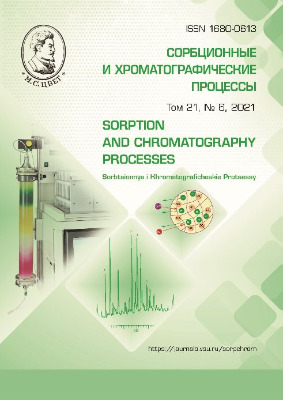Evaluation of the efficiency of extraction of mtDNA from the leukotrombocyte layer of human blood by commercial sorption kits
Abstract
Mitochondrial DNA (mtDNA) is widely used in various kinds of research, since changes in mtDNA (mutations or large-scale deletions) can cause a wide range of diseases such as diabetes, heart dysfunctions, various forms of cancer, etc. Isolation and quantification of mtDNA is often required to study the contribution of mtDNA to the development of pathologies. However, isolating a sufficient amount of mtDNA remains a challenge.
The aim of this study was the evaluation and comparison of three methods for the extraction of mtDNA from the human leukotrombocyte layer. All of our selected DNA extraction kits were based on the sorption extraction method, the principle of which is the special properties of silicon-based carriers for selective DNA binding. The effect of two commonly used types of anticoagulants on the efficiency of mtDNA extraction was also evaluated. Through a systematic comparison of mtDNA isolation methods, we have identified the procedure that provides the highest yield of mtDNA, which demonstrated high performance in subsequent analyses.
For mtDNA extraction, samples of the leukotrombocyte blood layer were taken from 12 volunteers and three different isolation protocols were used (Quick-DNA Miniprep Plus (Zymo Research, USA), Plasmid miniPrep (Evrogen, Russia) and QIAamp® Blood Mini Kit (QIAGEN, Germany)). Next, the amount of DNA was estimated using fluorimetry and quantitative polymerase chain reaction.
The obtained results showed that from the investigated methods of isolation, DNA extracted using the QIAamp® Blood Mini Kit (QIAGEN, Germany), based on the use of columns with a silica gel membrane, provides an optimal concentration of mtDNA. Differences between the amounts of mtDNA isolated from blood with different anticoagulants were not found. Our results emphasize the importance of choosing a method for mtDNA isolation, since this stage is crucial for obtaining high-quality mtDNA, which will be suitable for further molecular genetic studies.
Downloads
References
Weissig V., Edeas M. Mitochondrial Med., 2015, Vol. 1, pp. 1-480. DOI: https://10.1007/978-1-4939-2257-4.
Anderson S., Bankier A., Barrell B. et al., Nature, 1981, Vol. 290, pp. 457-465. DOI: https://10.1038/290457a0.
Zeviani M., Antozzi C., Mol. Hum. Reprod., 1997, Vol. 3, pp. 133-148. DOI: https://10.1093/molehr/3.2.133.
Bai R.K., Perng C.L., Hsu C.H., Wong L.J., Ann. N. Y. Acad. Sci., 2004, Vol. 1011, pp. 304-309. DOI: https://10.1007/978-3-662-41088-2_29.
Bornstein B., Area E., Flanigan K.M. et al., Neuromuscul. Disord., 2008, Vol. 18, p. 453. DOI: https://10.1016/j.nmd.2008.04.006.
Chan S.L., Copeland W.C., Biochim. Biophys. Acta, 2009, Vol. 1787, p. 312. DOI: https://10.1016/j.bbabio.2008.10.007.
Marín-García J., Akhmedov A.T., Moe G.W., Heart Fail. Rev., 2013, Vol. 18, pp. 439-456. DOI: https://10.1007/s10741-012-9330-2.
Lan Q., Lim U., Liu C.S. et al., Blood, 2008, Vol. 112, p. 4247. DOI: https://10.1182/blood-2008-05-157974
Xia P., An H.X., Dang C.X. et al., BMC Cancer, 2009, Vol. 9, p. 454. DOI: https://10.1186/1471-2407-9-454.
Timmermans E.C., Tebas P., Ruiter J.P. et. al., Clin. Chem., 2006, Vol. 52, pp. 979-987. DOI: https://10.1373/clinchem.2005.062901.
Lee H.K., Song J.H., Shin C.S. et al., Diabetes Res. Clin. Pract., 1998, Vol. 42, pp. 161-167. DOI: https://10.1016/s0168-8227(98)00110-7.
Weng S.W., Lin T.K., Liou C.W. et al., Diabetes Res. Clin. Pract., 2009, vol. 83, pp. 94-99. DOI: https://10.1016/j.diabres.2008.10.002.
Song J., Oh J.Y., Sung Y.A. et al., Diabetes Care, 2001, Vol. 24, pp. 865-869. DOI: https://10.2337/diacare.24.5.865.
Lee J.E., Park H., Ju Y.S. et. al. Exp. Mol. Med., 2009, Vol. 41, p. 253. DOI: https://10.3858/EMM.2009.41.4.028.
Elliott H.R., Samuels D.C., Eden J.A. et al., Am. J. Hum. Genet., 2008, Vol. 83, pp. 254-260. DOI: https://10.1016/J.AJHG.2008.07.004.
Brandon M.C., Lott M.T., Nguyen K.C., et. al. Nucleic Acids Res., 2005, vol. 33, pp. 611-613. DOI: https://10.1093/NAR/GKI079.
Gahan M.E., Miller F., Lewin S.R. et al., J. Clin. Virol., 2001, Vol. 22, pp. 241-247. DOI: https://10.1016/S1386-6532(01)00195-0.
Chabi B., Mousson de Camaret B., Duborjal H. et al., Clin. Chem., 2003, Vol. 49, pp. 1309-1317. DOI: https://10.1373/49.8.1309.
Meissner C., Mohamed S.A., Klueter H. et al., Forensic Sci. Int., 2000, Vol. 113, pp. 109-112. DOI: https://10.1016/S0379-0738(00)00249-8.
Cady N.C., Stelick S., Batt C.A., Bio-sensors & Bioelectronics, 2003, Vol. 19, No 1, pp. 59-66. DOI: https://10.1016/s0956-5663(03)00123-4.
Rimola A., Costa D., Sodupe M., Lambert J.F. et al., Chemical Reviews, 2013, Vol. 113, No 6, pp. 4216-4313. DOI: https://10.1021/cr3003054.
Zhang Y., Cremer P.S., Current Opinion in Chemical Biology, 2006, Vol. 10, No 6l, pp. 658-663. DOI: https://10.1016/j.cbpa.2006.09.020.
Poeckh T., Lopez S., Fuller A.O., Solomon M.J. et al., Analytical Biochemistry, 2008, Vol. 373, No 2, pp. 253-262. DOI: https://10.1016/j.ab.2007.10.026.
Smith K, Diggle MA, Clarke SC., J Clin Microbiol., 2003, Vol. 41, No 6, pp. 2440-2443. doi: https://10.1128/JCM.41.6.2440-2443.2003.
Claassen S., du Toit E., Kaba M., Moodley C. et al., Journal of microbiologi-cal methods, 2013, Vol. 94, No 2, pp. 103-110. https://doi.org/10.1016/j.mimet.2013.05.008







